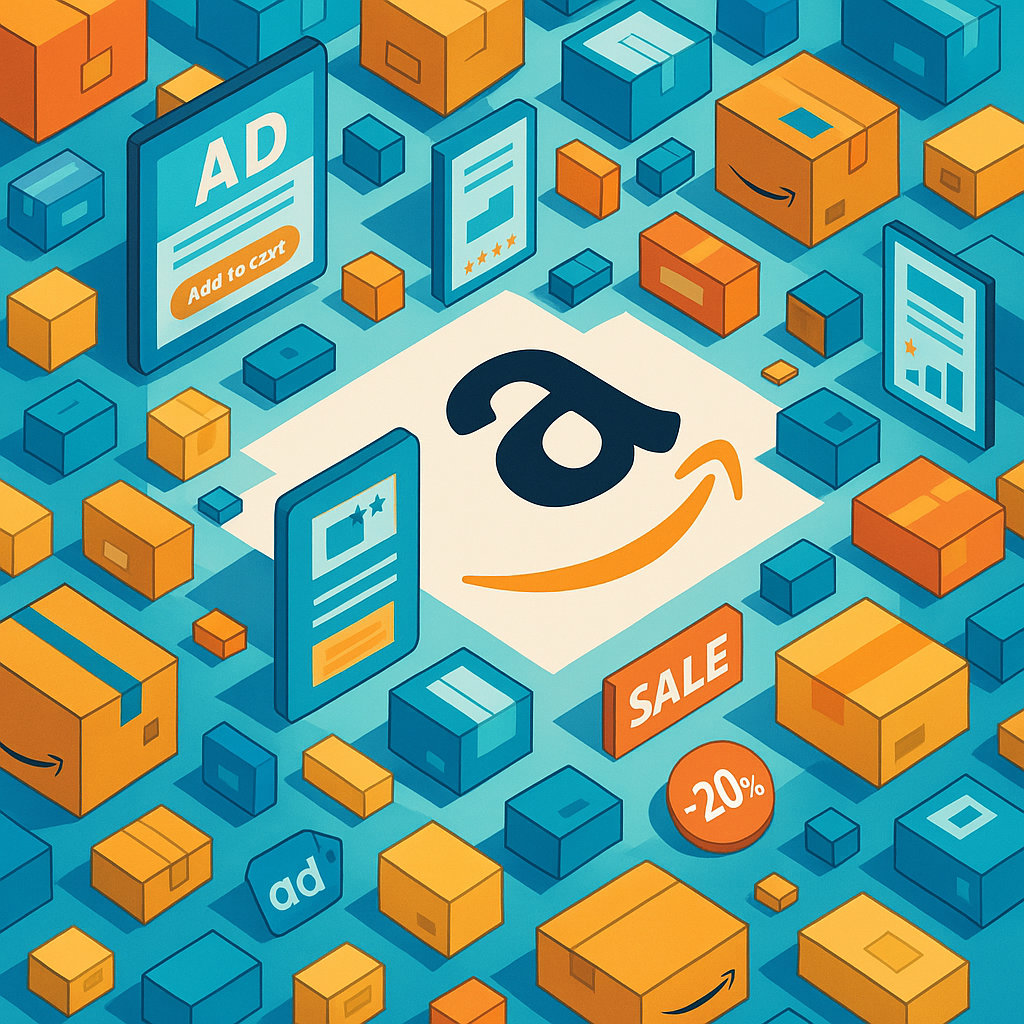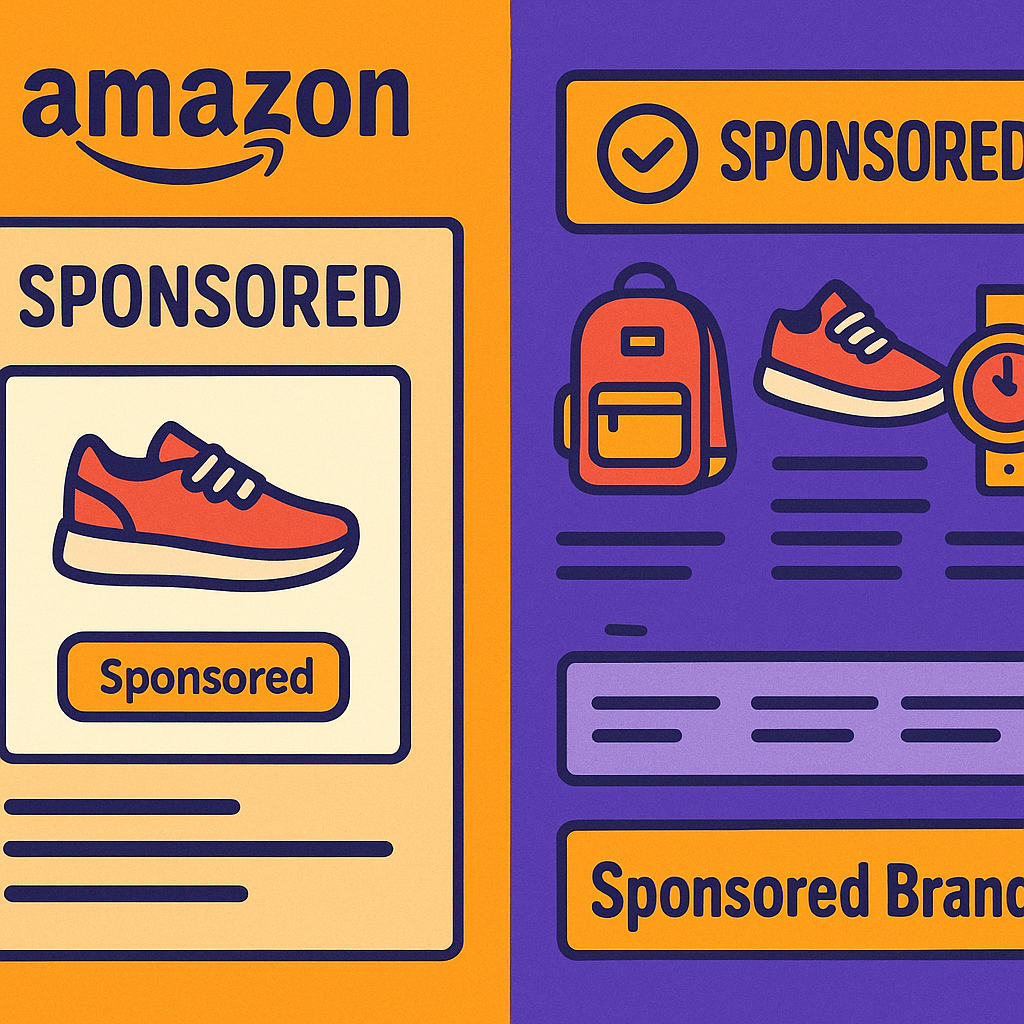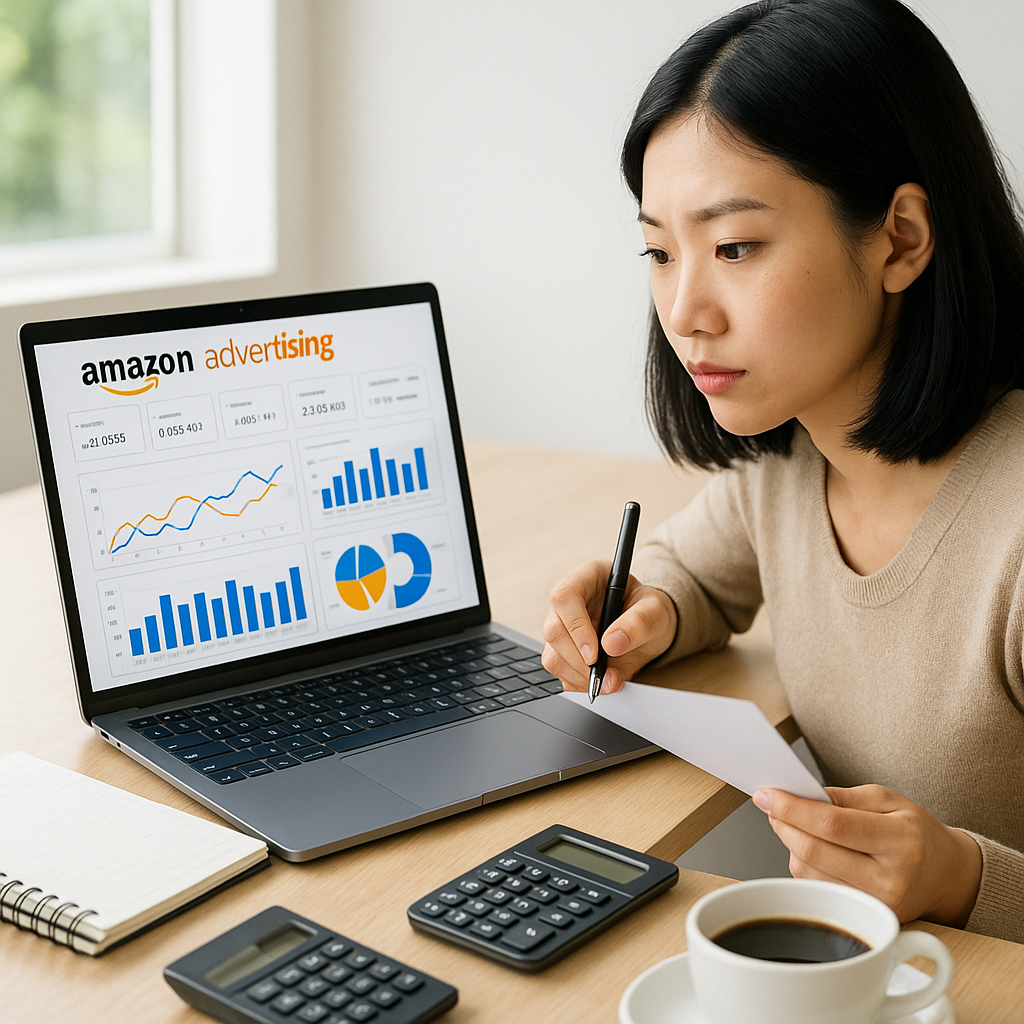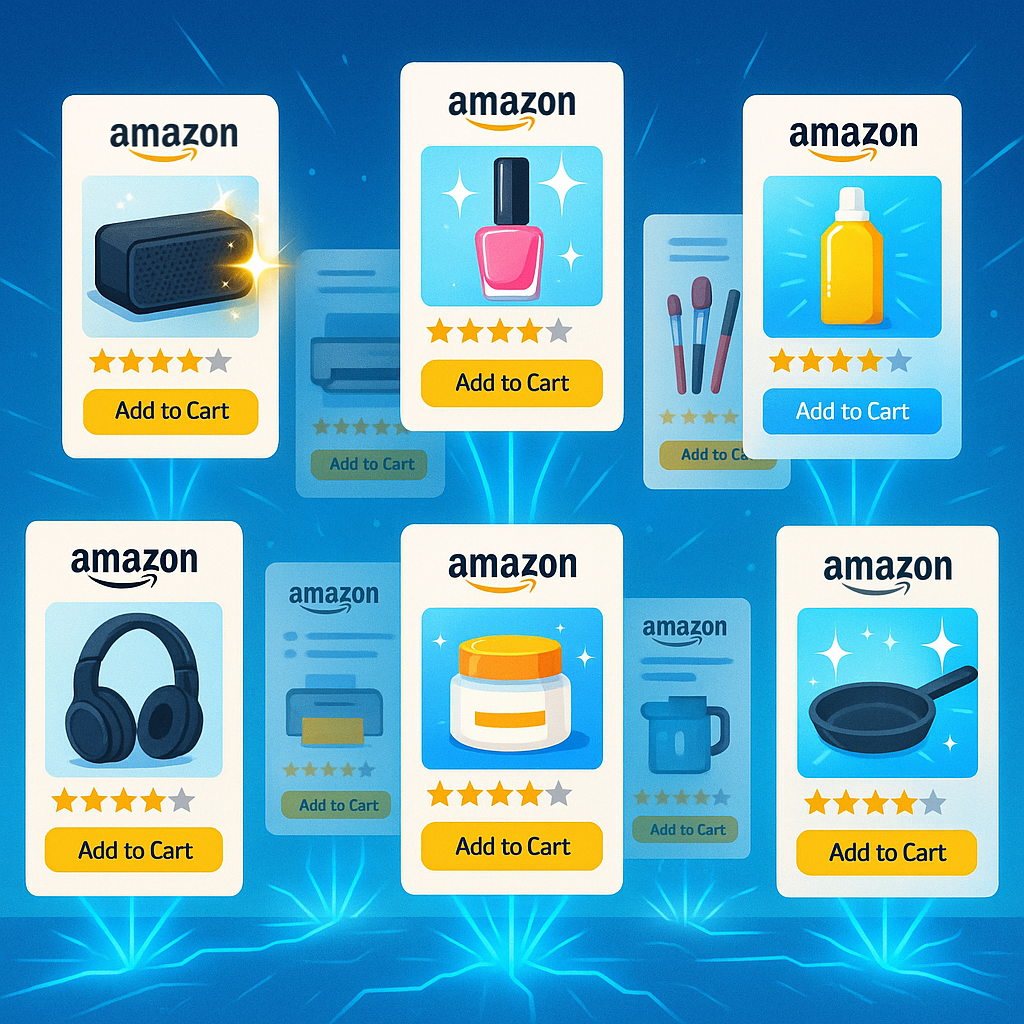How Much Does Amazon Advertising Cost? Breaking Down the Numbers
Understanding Amazon advertising costs isn’t just helpful—it’s essential for sellers and brands looking to succeed in the increasingly competitive marketplace. With over 2 million active sellers on Amazon, paid advertising has become virtually necessary to gain visibility and drive sales.
Whether you’re just starting out or looking to optimize your existing campaigns, knowing what factors influence your ad spend can mean the difference between profitable growth and wasted budget.
Amazon Advertising encompasses a variety of formats—from Sponsored Products and Brands to Display and Video ads—all operating primarily on auction-based, pay-per-click models where you only pay when shoppers interact with your ads. In this comprehensive guide, we’ll break down the actual costs you can expect, explore the factors that influence pricing, examine different ad types and their associated expenses, and provide practical budgeting strategies to help you make smart, efficient advertising decisions.
What affects the cost of advertising on Amazon?
When it comes to advertising costs on Amazon, there’s no one-size-fits-all pricing structure. Several dynamic factors influence how much you’ll ultimately spend to promote your products.
Ad type
Different ad formats command varying price points. Sponsored Products typically have the lowest barrier to entry, while video ads and Amazon DSP campaigns generally require higher investments. Your choice of ad type should align with both your budget constraints and marketing objectives.
Bidding strategy
Amazon’s advertising platform operates on an auction-based system where you compete against other sellers for placement. Aggressive bidding strategies can secure prime positions but at higher costs, while conservative approaches might save money but potentially sacrifice visibility. Dynamic bidding options (up and down, down only) also impact your cost structure by automatically adjusting bids based on conversion likelihood.
Keyword competition
High-demand keywords in popular categories can command premium prices. For instance, generic terms like “protein powder” or “bluetooth headphones” typically cost significantly more than long-tail, specific queries like “vegan pea protein unflavored” or “noise-canceling headphones for sleeping.” The level of competition for specific search terms directly impacts your cost-per-click.
Targeting options
Your targeting choices substantially affect advertising costs. Broad audience targeting generally costs less per impression but may yield lower conversion rates. Meanwhile, refined targeting based on detailed shopper behavior or interests often commands higher prices but can deliver better-qualified traffic and improved conversion rates.
Relevance and quality
The marketplace rewards relevance. Products with strong organic performance metrics (high click-through rates, conversion rates, and positive reviews) often enjoy more favorable ad placement at lower costs. Amazon’s algorithms prioritize listings that are likely to convert, which means investing in quality product pages can actually reduce your advertising costs over time.
Seasonality and demand
Market timing significantly impacts ad costs. During peak shopping periods like Prime Day, Black Friday, or holiday seasons, competition intensifies dramatically, driving up costs per click. Some sellers report CPC increases of 30-50% during Q4 compared to slower months. Planning campaigns with seasonality in mind helps manage budget expectations.
Product category
Different product categories have vastly different competitive landscapes. High-margin categories like beauty products, electronics, and home goods typically have more aggressive advertisers willing to pay premium rates. Niche categories or those with fewer sellers might offer more affordable advertising opportunities.
Amazon advertising types & their costs
Amazon offers several advertising models, each with its own cost structure and performance characteristics. Understanding these differences helps allocate your budget more effectively.
Sponsored Products
As Amazon’s most popular ad format, Sponsored Products operate on a straightforward pay-per-click model. These product-specific ads appear within search results and on product detail pages.
Cost structure: PPC (pay-per-click)
Average CPC range: $0.75-$3.50 (varies widely by category)
Minimum daily budget: $1 per day (recommended $10+ for meaningful data)
Best for: Individual product promotion, increasing visibility for new listings, boosting sales for specific ASINs
Sponsored Products generally offer the most efficient entry point for Amazon advertising, with many sellers reporting ACoS (Advertising Cost of Sale) between 15-30% when properly optimized. The auction-based pricing means you’ll never pay more than your maximum bid, though actual costs fluctuate based on real-time competition.
Sponsored Brands
These prominent banner-style ads showcase your brand logo, custom headline, and multiple products. They appear at the top, side, or within search results.
Cost structure: PPC (pay-per-click)
Average CPC range: $1.00-$5.00 (typically higher than Sponsored Products)
Minimum daily budget: $10 per day (recommended $20+ for competitive categories)
Best for: Brand awareness, featuring product collections, driving traffic to your Store
Sponsored Brands command higher CPCs due to their premium placement and enhanced visibility. However, they often deliver stronger brand engagement metrics, making them valuable for sellers focusing on brand building alongside immediate sales.
Sponsored Display
These versatile ads can appear both on and off Amazon, targeting shoppers based on interests, behaviors, or product views.
Cost structure: PPC (product targeting) or CPM (audience targeting)
Average CPC range: $0.80-$3.00
Average CPM range: $2.00-$6.00 (for 1,000 impressions)
Minimum daily budget: $1 per day (recommended $10+ for meaningful reach)
Best for: Retargeting, cross-selling, reaching shoppers with specific interests
Sponsored Display offers flexible targeting options that can help you reach shoppers at different stages of the buying journey. The contextual placement of these ads often results in moderate costs compared to more premium formats.
Amazon DSP (Demand-Side Platform)
The Amazon DSP provides programmatic advertising capabilities to reach audiences both on and off Amazon properties.
Cost structure: CPM (cost per thousand impressions)
Average CPM range: $3.50-$15.00 (depending on targeting precision)
Minimum spend: Self-service ($5,000+ monthly), Managed service ($50,000+ monthly)
Best for: Sophisticated brand campaigns, off-Amazon targeting, advanced audience segmentation
DSP represents Amazon’s most advanced advertising solution, with correspondingly higher entry costs. The platform delivers extensive audience insights and targeting capabilities but requires significant investment in both budget and expertise.
Video & Audio Ads
These premium formats deliver engaging content across Amazon’s streaming properties and devices.
Cost structure: CPM or cost-per-view (CPV)
Average CPM range: $15.00-$30.00
Minimum spend: Generally starts at $15,000-$25,000 for managed campaigns
Best for: Brand storytelling, product demonstrations, reaching streaming audiences
Video advertising commands premium rates but offers unmatched engagement potential. These formats work best for established brands with professional creative assets and substantial marketing budgets.
Amazon ad pricing models explained
Understanding the different pricing models helps forecast and control your advertising expenditure:
- CPC (Cost-Per-Click): You pay only when a shopper clicks your ad. This model aligns costs with actual interest and works well for direct-response campaigns.
- CPM (Cost-Per-Mille/thousand impressions): You pay based on ad views, regardless of clicks. This model suits awareness-focused campaigns where visibility is the primary goal.
- vCPM (viewable Cost-Per-Mille): Similar to CPM, but you only pay for ads that are actually viewable on screen, eliminating charges for unseen impressions.
- CPV (Cost-Per-View): Used primarily for video ads, you pay when viewers watch a certain duration of your video content.
Budgeting for Amazon advertising: how much should you spend?
Determining an appropriate advertising budget requires balancing your business objectives with financial constraints. While there’s no universal formula, several approaches can guide your decision-making process.
Setting a daily/monthly budget
When establishing your advertising investment, consider these practical guidelines:
- Percentage of revenue: Many successful Amazon sellers allocate 15-30% of their product revenue to advertising, adjusting based on margins and growth goals.
- Testing budget: For new campaigns or products, start with $10-50 daily for at least two weeks to gather meaningful performance data.
- Competitive analysis: Research your category’s typical advertising intensity—highly competitive niches may require higher relative spend to achieve visibility.
- Seasonal adjustments: Plan to increase budgets by 20-50% during peak selling periods to maintain visibility when competition intensifies.
Remember that underfunding campaigns can lead to inconsistent data and missed opportunities, while excessive spending without proper optimization risks poor returns.
Calculating maximum CPC and bids
Strategic bid setting relies on understanding your profit margins and acceptable advertising cost of sale (ACoS):
- Calculate your break-even ACoS: (Profit Margin ÷ Product Price) × 100
- Determine target ACoS based on your goals (lower for profit focus, higher for growth focus)
- Calculate maximum CPC: (Average Order Value × Conversion Rate × Target ACoS) ÷ 100
For example, if you sell a $40 product with a 40% margin and 10% conversion rate, targeting a 25% ACoS:
Maximum CPC = ($40 × 10% × 25%) ÷ 100 = $1.00
This formula provides a rational starting point for bid setting that aligns with your business economics.
Scaling ad spend with results
Sustainable advertising growth follows a measured progression:
- Test phase: Begin with modest budgets across multiple campaign types to identify what works.
- Optimization phase: Once you’ve collected sufficient data, refine targeting and eliminate underperforming keywords or placements.
- Scaling phase: Incrementally increase budgets (15-20% at a time) for successful campaigns while monitoring performance metrics.
- Expansion phase: Diversify into additional ad formats as core campaigns demonstrate consistent performance.
This methodical approach minimizes risk while allowing for meaningful growth in advertising investment as returns justify increased spending.
Balancing Amazon with other ad platforms
Amazon advertising should be considered within your broader marketing ecosystem. Several factors influence its relative importance:
- Customer journey position: Amazon excels at capturing high-intent shoppers, making it ideal for bottom-funnel conversion, while platforms like Meta or Google may better serve awareness and consideration stages.
- Product characteristics: Items requiring minimal explanation or with strong impulse-buy potential often perform exceptionally well on Amazon compared to other channels.
- Competitive landscape: Categories with intense on-platform competition may necessitate supplementary off-Amazon advertising to drive initial interest.
- Brand maturity: Established brands can often leverage their reputation for efficient Amazon conversion, while newer brands might need broader exposure elsewhere first.
Many successful merchants employ a hub-and-spoke model, with Amazon as their primary sales channel supported by strategic investments in complementary platforms to create a comprehensive marketing funnel.
Optimizing and managing Amazon advertising spend
Maximizing return on investment requires ongoing attention to campaign performance and strategic adjustments. Effective optimization can dramatically improve efficiency, often reducing costs while simultaneously increasing sales.
Keyword strategy optimization
Refining your keyword approach represents one of the most powerful levers for cost efficiency:
- Search term analysis: Regularly review search term reports to identify high-converting customer queries for addition as exact-match keywords.
- Negative keyword implementation: Aggressively exclude irrelevant or underperforming terms to prevent wasted spend on unqualified clicks.
- Match type progression: Start campaigns with broad match to gather data, then refine toward phrase and exact matches as you identify winning terms.
- Long-tail expansion: Target specific, detailed phrases that typically have lower competition and costs while attracting highly qualified shoppers.
Implementing a structured keyword refinement process can reduce wasted ad spend by 20-30% while simultaneously improving relevance signals to Amazon’s algorithms.
Listing optimization for ad performance
Your organic product listing directly influences advertising effectiveness:
- Image quality: Professional, clear images improve click-through rates and conversion, lowering effective ad costs.
- Title optimization: Strategic keyword placement in titles enhances relevance for both organic and sponsored placements.
- Bullet point refinement: Concise, benefit-focused bullet points support conversion after ad clicks.
- Backend search terms: Fully utilize all available backend keyword fields to strengthen relevance signals.
Well-optimized listings can improve conversion rates by 15-30%, dramatically enhancing advertising efficiency by reducing the cost to acquire each sale.
Campaign structure best practices
Organizational clarity enables precise performance analysis and targeted optimization:
- Campaign segmentation: Separate campaigns by product category, margin profile, or business objective to allow tailored bidding strategies.
- Automatic/manual pairing: Run automatic campaigns to discover converting search terms, then transfer these to manual campaigns for refined bidding control.
- Ad group focus: Limit ad groups to closely related products to maintain tight thematic relevance.
- Strategic placement adjustments: Modify bids by placement (top of search, product pages) based on performance data to maximize efficient spending.
Proper campaign architecture enables precision targeting of ad dollars toward your most profitable opportunities while providing clear visibility into performance metrics.
Bidding strategy refinement
Sophisticated bid management dramatically impacts campaign economics:
- Dayparting: Adjust bids based on hourly performance patterns, reducing spend during low-conversion periods.
- Dynamic bid adjustment: Utilize Amazon’s dynamic bidding options (up and down, down only) based on campaign objectives and performance.
- Placement modifiers: Apply percentage adjustments to bids based on placement performance data.
- Seasonal bid strategy: Proactively adjust bids to account for seasonal competition fluctuations and conversion rate changes.
Advanced bidding tactics can improve ACOS by 15-25% compared to static bidding approaches by allocating spend more efficiently across different contexts.
Amazon advertising tools
Leveraging both native and third-party tools enhances management capabilities:
Amazon native tools:
- Advertising Console: Core platform for campaign creation, management, and basic reporting.
- Brand Analytics: Provides valuable search term ranking, market basket, and demographic insights (available to Brand Registry members).
- Amazon Marketing Cloud: Advanced analytics platform for cross-channel measurement (enterprise advertisers).
Third-party tools:
- Helium 10 (Adtomic): Offers automated optimization, advanced analytics, and keyword research ($37-197/month).
- SellerApp: Provides comprehensive PPC management, bid automation, and competitor analysis ($49-399/month).
- AdBadger: Features rule-based automation, performance alerts, and visualization tools ($29-99/month).
While adding cost, these tools can significantly improve efficiency through automation, deeper analytics, and time savings for campaign managers.
Performance monitoring and optimization cycles
Establishing consistent review processes ensures continuous improvement:
- Key metrics tracking: Monitor ACOS, ROAS, impression share, and conversion rates across different segments.
- Structured optimization schedule: Implement weekly bid adjustments, bi-weekly keyword refinements, and monthly strategy reviews.
- A/B testing: Systematically test creative elements, targeting approaches, and bidding strategies to identify improvements.
- Portfolio-level analysis: Evaluate performance across your entire advertising portfolio to identify resource allocation opportunities.
Disciplined performance management typically yields 5-15% efficiency improvements quarter-over-quarter as optimizations compound.
Conclusion
Amazon advertising costs vary significantly based on numerous factors including ad type, competition, category, and campaign execution. While Sponsored Products might start at less than a dollar per click, comprehensive brand campaigns across multiple formats can require thousands in monthly investment. The key to success lies not in finding a single “right” budget figure but in adopting a strategic approach that aligns spending with specific business objectives.
The most successful Amazon advertisers recognize that costs should be viewed in the context of return on investment. By starting with conservative budgets, testing methodically, optimizing continuously, and scaling gradually, sellers can develop profitable advertising campaigns regardless of their initial budget constraints.
Remember that advertising efficiency improves with experience—what begins as a 40% ACOS campaign can often be refined to 20-25% through systematic optimization. As you gain proficiency with Amazon’s advertising ecosystem, you’ll develop an increasingly nuanced understanding of the relationship between spending and results in your specific product categories.
Whether you’re investing $10 per day or $10,000, the principles remain consistent: maintain a data-driven approach, focus relentlessly on relevance, and view advertising as an ongoing process rather than a one-time setup.
Frequently asked questions
How much does Amazon advertising cost on average?
The average CPC for Amazon Sponsored Products is around $0.95, but exact costs depend on competition, ad type, and time of year. Costs typically range from $0.75 to $3.50 per click across different categories.
What is the minimum budget I need to start with Amazon ads?
You can start with as little as $10/day, but most see better results with a slightly higher budget, especially in competitive categories. For meaningful data collection, plan to invest at least $300-500 over a two-week initial testing period.
Is Amazon advertising cost-effective compared to Google or Meta ads?
Amazon ads often have higher buyer intent and conversion rates, but costs per click (CPC) and return vary based on your product and niche. Amazon typically excels for bottom-funnel conversion, while Google and Meta may offer advantages for awareness and consideration phases.
How do I calculate my ACOS (Advertising Cost of Sale) on Amazon?
Divide your total ad spend by the total sales generated from ads, expressed as a percentage (e.g., $30 ad spend / $100 sales = 30% ACOS). Lower ACOS indicates more efficient advertising, though target rates vary based on profit margins and business objectives.
Can I advertise on Amazon if I don’t sell on the platform?
Yes—certain ad products like Amazon DSP, video, and display campaigns are available to off-Amazon brands as well. These options allow external websites and brands to leverage Amazon’s audience data and reach without selling directly on the marketplace.
